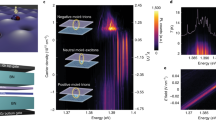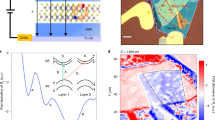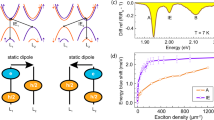Abstract
Transition metal dichalcogenides (TMDs) constitute a versatile platform for atomically thin optoelectronics devices and spin–valley memory applications. In monolayer TMDs the optical absorption is strong, but the transition energy cannot be tuned as the neutral exciton has essentially no out-of-plane static electric dipole1,2. In contrast, interlayer exciton transitions in heterobilayers are widely tunable in applied electric fields, but their coupling to light is substantially reduced. In this work, we show tuning over 120 meV of interlayer excitons with a high oscillator strength in bilayer MoS2 due to the quantum-confined Stark effect3. We optically probed the interaction between intra- and interlayer excitons as they were energetically tuned into resonance. Interlayer excitons interact strongly with intralayer B excitons, as demonstrated by a clear avoided crossing, whereas the interaction with intralayer A excitons is substantially weaker. Our observations are supported by density functional theory (DFT) calculations, which include excitonic effects. In MoS2 trilayers, our experiments uncovered two types of interlayer excitons with and without in-built electric dipoles. Highly tunable excitonic transitions with large in-built dipoles and oscillator strengths will result in strong exciton–exciton interactions and therefore hold great promise for non-linear optics with polaritons.
This is a preview of subscription content, access via your institution
Access options
Access Nature and 54 other Nature Portfolio journals
Get Nature+, our best-value online-access subscription
$29.99 / 30 days
cancel any time
Subscribe to this journal
Receive 12 print issues and online access
$259.00 per year
only $21.58 per issue
Buy this article
- Purchase on Springer Link
- Instant access to full article PDF
Prices may be subject to local taxes which are calculated during checkout




Similar content being viewed by others
Data availability
The data that support the plots within this paper and other findings of this study are available from the corresponding author upon reasonable request.
References
Roch, J. G. et al. Quantum-confined Stark effect in a MoS2 monolayer van der Waals heterostructure. Nano Lett. 18, 1070–1074 (2018).
Verzhbitskiy, I., Vella, D., Watanabe, K., Taniguchi, T. & Eda, G. Suppressed out-of-plane polarizability of free excitons in monolayer WSe2. ACS Nano 13, 3218–3224 (2019).
Miller, D. A. et al. Band-edge electroabsorption in quantum well structures: the quantum-confined Stark effect. Phys. Rev. Lett. 53, 2173 (1984).
Chernikov, A. et al. Exciton binding energy and nonhydrogenic Rydberg series in monolayer WS2. Phys. Rev. Lett. 113, 076802 (2014).
Wang, G. et al. Colloquium: excitons in atomically thin transition metal dichalcogenides. Rev. Mod. Phys. 90, 021001 (2018).
Scuri, G. et al. Large excitonic reflectivity of monolayer MoSe2 encapsulated in hexagonal boron nitride. Phys. Rev. Lett. 120, 037402 (2018).
Back, P., Zeytinoglu, S., Ijaz, A., Kroner, M. & Imamoğlu, A. Realization of an electrically tunable narrow-bandwidth atomically thin mirror using monolayer MoSe2. Phys. Rev. Lett. 120, 037401 (2018).
Rivera, P. et al. Observation of long-lived interlayer excitons in monolayer MoSe2-WSe2 heterostructures. Nat. Commun. 6, 6242 (2015).
Joe, A. Y. et al. Electrically controlled emission from triplet charged excitons in atomically thin heterostructures. Preprint at https://arxiv.org/abs/1912.07678 (2019).
Unuchek, D. et al. Valley-polarized exciton currents in a van der Waals heterostructure. Nat. Nanotechnol. 14, 1104–1109 (2019).
Nagler, P. et al. Interlayer exciton dynamics in a dichalcogenide monolayer heterostructure. 2D Mater. 4, 025112 (2017).
Förg, M. et al. Cavity-control of interlayer excitons in van der Waals heterostructures. Nat. Commun. 10, 3697 (2019).
Slobodeniuk, A. et al. Fine structure of K-excitons in multilayers of transition metal dichalcogenides. 2D Mater. 6, 025026 (2019).
Calman, E. et al. Indirect excitons in van der Waals heterostructures at room temperature. Nat. Commun. 9, 1895 (2018).
Gerber, I. C. et al. Interlayer excitons in bilayer MoS2 with strong oscillator strength up to room temperature. Phys. Rev. B 99, 035443 (2019).
Niehues, I., Blob, A., Stiehm, T., de Vasconcellos, S. M. & Bratschitsch, R. Interlayer excitons in bilayer MoS2 under uniaxial tensile strain. Nanoscale 11, 12788–12792 (2019).
Carrascoso, F., Lin, D.-Y., Frisenda, R. & Castellanos-Gomez, A. Biaxial strain tuning of interlayer excitons in bilayer MoS2. J. Phys. Mater. 3, 015003 (2019).
Deilmann, T. & Thygesen, K. S. Interlayer excitons with large optical amplitudes in layered van der Waals materials. Nano Lett. 18, 2984–2989 (2018).
Pisoni, R. et al. Absence of interlayer tunnel coupling of K-valley electrons in bilayer MoS2. Phys. Rev. Lett. 123, 117702 (2019).
Gong, Z. et al. Magnetoelectric effects and valley-controlled spin quantum gates in transition metal dichalcogenide bilayers. Nat. Commun. 4, 2053 (2013).
Arora, A. et al. Interlayer excitons in a bulk van der Waals semiconductor. Nat. Commun. 8, 639 (2017).
Nagler, P. et al. Interlayer excitons in transition-metal dichalcogenide heterobilayers. Phys. Status Solidi B 256, 1900308 (2019).
Wu, S. et al. Electrical tuning of valley magnetic moment through symmetry control in bilayer MoS2. Nat. Phys. 9, 149–153 (2013).
Jones, A. M. et al. Spin–layer locking effects in optical orientation of exciton spin in bilayer WSe2. Nat. Phys. 10, 130–134 (2014).
Lindlau, J. et al. The role of momentum-dark excitons in the elementary optical response of bilayer WSe2. Nat. Commun. 9, 2586 (2018).
Wang, Z., Chiu, Y.-H., Honz, K., Mak, K. F. & Shan, J. Electrical tuning of interlayer exciton gases in WSe2 bilayers. Nano Lett. 18, 137–143 (2017).
Horng, J. et al. Observation of interlayer excitons in MoSe2 single crystals. Phys. Rev. B 97, 241404 (2018).
Shimazaki, Y. et al. Strongly correlated electrons and hybrid excitons in a moiré heterostructure. Nature 580, 472–477 (2020).
Sung, J. et al. Broken mirror symmetry in excitonic response of reconstructed domains in twisted MoSe2/MoSe2 bilayers. Nat. Nanotechnol. https://doi.org/10.1038/s41565-020-0728-z (2020).
Arora, A. et al. Valley-contrasting optics of interlayer excitons in Mo-and W-based bulk transition metal dichalcogenides. Nanoscale 10, 15571–15577 (2018).
Fan, X., Singh, D. J. & Zheng, W. Valence band splitting on multilayer MoS2: mixing of spin–orbit coupling and interlayer coupling. J. Phys. Chem. Lett. 7, 2175–2181 (2016).
Liu, Q. et al. Tuning electronic structure of bilayer MoS2 by vertical electric field: a first-principles investigation. J. Phys. Chem. C. 116, 21556–21562 (2012).
Cristofolini, P. et al. Coupling quantum tunneling with cavity photons. Science 336, 704–707 (2012).
Schneider, C., Glazov, M. M., Korn, T., Höfling, S. & Urbaszek, B. Two-dimensional semiconductors in the regime of strong light–matter coupling. Nat. Commun. 3, 2695 (2018).
Muñoz-Matutano, G. et al. Emergence of quantum correlations from interacting fibre-cavity polaritons. Nat. Mater. 18, 213–218 (2019).
Delteil, A. et al. Towards polariton blockade of confined exciton–polaritons. Nat. Mater. 18, 219–222 (2019).
Roch, J. G. et al. Spin-polarized electrons in monolayer MoS2. Nat. Nanotechnol. 14, 432–436 (2019).
Acknowledgements
N.L., L.S. and R.J.W. acknowledge funding from the PhD School Quantum Computing and Quantum Technology, SNF (project no. 200020_156637), Swiss Nanoscience Institute and NCCR QSIT. S.S., I.P., C.R., D.L., A.B., X.M., I.C.G. and B.U. acknowledge funding from ANR 2D-vdW-Spin, ANR VallEx, ANR MagicValley, ITN 4PHOTON Marie Sklodowska Curie grant agreement no. 721394 and the Institut Universitaire de France. K.W. and T.T. acknowledge support from the Elemental Strategy Initiative conducted by the MEXT, Japan, grant no. JPMXP0112101001, JSPS KAKENHI grant no. JP20H00354 and the CREST(JPMJCR15F3), JST. I.C.G. thanks the CALMIP initiative for the generous allocation of computational time, through the project p0812, as well as GENCI-CINES and GENCI-IDRIS for grant A006096649. We thank J.-M. Poumirol for the atomic force microscopy measurements and J. G. Roch for crucial help at early stages of this work.
Author information
Authors and Affiliations
Contributions
T.T. and K.W. grew the high-quality hBN bulk crystal. N.L., S.S., I.P. and C.R. fabricated the encapsulated samples. D.L. designed and built the magneto-optics set-up. N.L., S.S., I.P., L.S. and C.R. performed optical spectroscopy measurements. N.L, L.S., I.P., S.S., C.R., A.B. and X.M. analysed the optical spectra and interpreted the data. I.C.G. performed the DFT GW+BSE calculations. R.J.W. and B.U. suggested the experiments and supervised the project. N.L., I.C.G. and B.U. wrote the manuscript with input from all the authors.
Corresponding author
Ethics declarations
Competing interests
The authors declare no competing interests.
Additional information
Peer review information Nature Nanotechnology thanks Thomas Volz and the other, anonymous, reviewer for their contribution to the peer review of this work.
Publisher’s note Springer Nature remains neutral with regard to jurisdictional claims in published maps and institutional affiliations.
Supplementary information
Supplementary Information
Supplementary Figs. 1–10, Discussion and Tables I and II.
Rights and permissions
About this article
Cite this article
Leisgang, N., Shree, S., Paradisanos, I. et al. Giant Stark splitting of an exciton in bilayer MoS2. Nat. Nanotechnol. 15, 901–907 (2020). https://doi.org/10.1038/s41565-020-0750-1
Received:
Accepted:
Published:
Issue Date:
DOI: https://doi.org/10.1038/s41565-020-0750-1
This article is cited by
-
Ultraviolet interlayer excitons in bilayer WSe2
Nature Nanotechnology (2024)
-
High-throughput computational stacking reveals emergent properties in natural van der Waals bilayers
Nature Communications (2024)
-
Giant Faraday rotation in atomically thin semiconductors
Nature Communications (2024)
-
Engineering interlayer hybridization in van der Waals bilayers
Nature Reviews Materials (2024)
-
Interspecies exciton interactions lead to enhanced nonlinearity of dipolar excitons and polaritons in MoS2 homobilayers
Nature Communications (2023)



